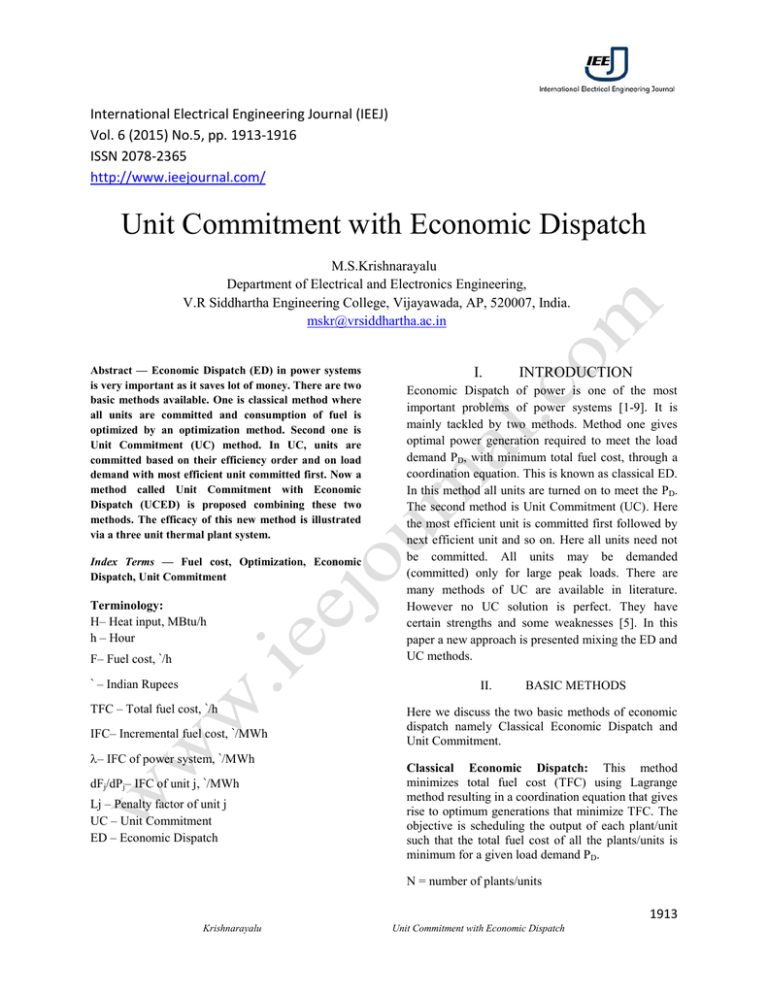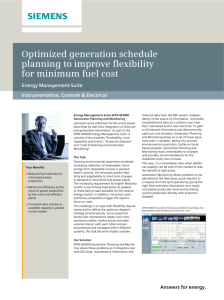Unit Commitment with Economic Dispatch
advertisement

International Electrical Engineering Journal (IEEJ) Vol. 6 (2015) No.5, pp. 1913-1916 ISSN 2078-2365 http://www.ieejournal.com/ Unit Commitment with Economic Dispatch M.S.Krishnarayalu Department of Electrical and Electronics Engineering, V.R Siddhartha Engineering College, Vijayawada, AP, 520007, India. mskr@vrsiddhartha.ac.in Abstract — Economic Dispatch (ED) in power systems is very important as it saves lot of money. There are two basic methods available. One is classical method where all units are committed and consumption of fuel is optimized by an optimization method. Second one is Unit Commitment (UC) method. In UC, units are committed based on their efficiency order and on load demand with most efficient unit committed first. Now a method called Unit Commitment with Economic Dispatch (UCED) is proposed combining these two methods. The efficacy of this new method is illustrated via a three unit thermal plant system. Index Terms — Fuel cost, Optimization, Economic Dispatch, Unit Commitment Terminology: H– Heat input, MBtu/h h – Hour F– Fuel cost, `/h ` – Indian Rupees I. II. TFC – Total fuel cost, `/h IFC– Incremental fuel cost, `/MWh – IFC of power system, `/MWh dFj/dPj– IFC of unit j, `/MWh Lj – Penalty factor of unit j UC – Unit Commitment ED – Economic Dispatch INTRODUCTION Economic Dispatch of power is one of the most important problems of power systems [1-9]. It is mainly tackled by two methods. Method one gives optimal power generation required to meet the load demand PD, with minimum total fuel cost, through a coordination equation. This is known as classical ED. In this method all units are turned on to meet the PD. The second method is Unit Commitment (UC). Here the most efficient unit is committed first followed by next efficient unit and so on. Here all units need not be committed. All units may be demanded (committed) only for large peak loads. There are many methods of UC are available in literature. However no UC solution is perfect. They have certain strengths and some weaknesses [5]. In this paper a new approach is presented mixing the ED and UC methods. BASIC METHODS Here we discuss the two basic methods of economic dispatch namely Classical Economic Dispatch and Unit Commitment. Classical Economic Dispatch: This method minimizes total fuel cost (TFC) using Lagrange method resulting in a coordination equation that gives rise to optimum generations that minimize TFC. The objective is scheduling the output of each plant/unit such that the total fuel cost of all the plants/units is minimum for a given load demand PD. N = number of plants/units 1913 Krishnarayalu Unit Commitment with Economic Dispatch International Electrical Engineering Journal (IEEJ) Vol. 6 (2015) No.5, pp. 1913-1916 ISSN 2078-2365 http://www.ieejournal.com/ TFC = F1+ F2+…+ FN=∑𝑁 (1) 𝑗=1 𝐹𝑗 F1, F2,…,FN - fuel cost of individual plants/units PT = total power input to the network from all plants/units = P1+ P2+…+ PN=∑𝑁 (2) 𝑗=1 𝑃𝑗 P1, P2,…,PN - power outputs of individual plants/units PD = total power demanded by the loads of the entire system PL = total transmission loss Hence Ф = PD + PL- ∑𝑁 (3) 𝑗=1 𝑃𝑗 = 0 is the equality constraint for optimization. L = FT + Ф = Lagrange function = augmented cost function (4) - a constant called Lagrangian multiplier For minimum FT, L/Pj = 0, j This results in = (dFj/dPj) / [1- (PL /Pj)], = Lj (dFj/dPj), `/MWh j = 1, … N. (5) (5) is the coordination equation for finding optimum generation schedules that minimize TFC. Lj= 1/[1- (PL /Pj)] = penalty factor for plant j = 1 if transmission losses were neglected (zero). If transmission losses are included Lj will be more (penalty) and IFC of the power system will be high. If maximum and minimum generations are specified for each unit, some units will be unable to operate at the same IFC as others. Then dFj/dPj≥ , Pj = Pjmin dFj/dPj=, Pjmin<Pj<Pjmax dFj/dPj≤ , Pj = Pjmax (6) Unit Commitment: To commit a generating unit is to turn it on. That is to bring the unit up to rated speed, synchronize it to the system so that it can deliver power to the network. A great deal of money (fuel) can be saved by turning the units off (decommitting) when they are not needed. The salient points of UC are It is not economical to run all the units available all the time. Determination of units of a plant that should operate for a particular load UC is important for thermal power plants than other types of plants such as hydro (the operating cost and start-up times for hydro plants are negligible). Constraints in UC: Many constraints like online and offline reserves, minimum up time, minimum down time, crew constraints, maintenance constraints are to be considered in UC for committing and decommitting of units. The UC problem can be very difficult. Let us consider the following situation. 1) It is required to establish a loading pattern for M intervals per day. Then M will be 24 for one hour interval. 2) There are N units to commit and dispatch. 3) Any one unit can supply the total load demand PD. Also any combination of units can also supply the PD. For the total period of M intervals, the maximum no. of possible combinations is (2N-1)M which can be a very large number. For N=20, (2 N-1)24 =3.12 x10144, indicates the difficulty of UC. Some approaches of UC Priority List method: A simple approach to the problem is to apply priority ordering (most efficient plant/unit is loaded first and so on). Efficiency of units may be determined from full load average production costs of units. Optimal approach using Dynamic programming Lagrange Relaxation method Mixed Integer Programming III. UNIT COMMITMENT WITH ECONOMIC DISPATCH (UCED) Here a method named Unit Commitment with Economic Dispatch (UCED) is proposed combining the basic principles of Economic Dispatch and Unit Commitment methods. Firstly list out the units according to their efficiency. Initially the most 1914 Krishnarayalu Unit Commitment with Economic Dispatch International Electrical Engineering Journal (IEEJ) Vol. 6 (2015) No.5, pp. 1913-1916 ISSN 2078-2365 http://www.ieejournal.com/ efficient unit is committed as in UC. Continue loading this unit till maximum generation according to PD. If PD is more than maximum generation limit of this unit, commit the next most efficient unit. Now using the coordination equation (5) determine the optimum generations of these two units for the P D. Continue this process by committing next efficient unit as PD increases further. Also continue to find optimum generations using the coordination equation (5). Here computations are unique. Firstly the most efficient unit is committed. Accordingly P D is supplied by this unit till its maximum generation limit is reached. When next unit is committed optimal power generation is computed using coordination equation (5). Hence computations are unique. IV. Table 3 : Unit Efficiency Order Unit 1 2 3 IFC = dF/dP `/MWh IFC at Full Load Efficiency Order `/MWh 97.94 94.02 118.78 2 1 3 79.2+0.03124P1 78.5+0.0194P2 95.64+0.11568P3 Load demand PD varies from 300 MW to 1200 MW. Optimum power generations and total fuel cost (TFC) for classical ED, UC and UCED methods are computed and shown in Tables 4, 5 and 6 respectively. From these tables it can be observed UCED method is the most economical compared to classical ED and Unit Commitment methods. CASE STUDY Consider a three unit thermal plant with the following data. Here transmission losses are neglected. Table 1: Data of three unit thermal plant Unit 1 2 3 H, MBtu/h Cost of 510+7.2P1+0.00142P1^2 310+7.85P2+0.00194P2^2 78+7.97P3+0.00482P3^2 MBtu, ` 11 10 12 Pmin, MW Pmax, MW 150 100 50 600 400 200 Table 4: ED – Classical The resulting fuel cost and unit efficiency order are given in Tables 2 and 3 respectively. Table 2: Fuel Cost Unit 1 2 3 F, `/h 5610+79.2P1+0.01562P1^2 3100+78.5P2+0.0194P2^2 936+95.64P3+0.05784P3^2 PD, MW P1, MW P2, MW 300 400 500 600 700 800 900 1000 1100 1200 150 183.9 239.29 294.69 350.09 405.48 460.88 477.185 600 600 100 166.1 210.71 255.31 299.91 344.52 389.12 400 400 400 ED P3, MW 50 50 50 50 50 50 50 122.815 100 200 TFC, `/h 34848 43240 51821 60575 69502 78602 87876 98118 10744 11873 1915 Krishnarayalu Unit Commitment with Economic Dispatch International Electrical Engineering Journal (IEEJ) Vol. 6 (2015) No.5, pp. 1913-1916 ISSN 2078-2365 http://www.ieejournal.com/ Table 5: UC – Priority List Method PD, MW P1, MW P2, MW 300 400 500 600 700 800 900 1000 1100 1200 0 0 100 200 300 400 500 600 600 600 300 400 400 400 400 400 400 400 400 400 UC P3, MW TFC, 0 0 0 0 0 0 0 0 100 200 `/h 28396 37604 51290 59679 68380 77393 86719 96357 10744 11873 committed for a given PD. In UCED only required number of units is committed according to PD as in UC. In UCED computations are unique not trial and error values. A three unit thermal power system is taken as a case study. From Tables 4 and 5 UC is economical than classical ED. Comparing Tables 4,5 and 6 UCED is the most economical for different P D. Here what is presented is the basic idea of UCED only, viz commit the units based on their efficiency and share the load according to coordination equation (5) if number of units is two or more. Further research on this method may leads to its commercial use. ACKNOWLEDGEMENTS The author greatly acknowledges Siddhartha Academy of General and Technical Education, Vijayawada for providing the facilities to carry out this research. Table 6: UCED PD, MW P1, MW UCED P2, MW P3, MW TFC, 300 400 500 600 700 800 900 1000 1100 1200 0 0 266.99 322.39 377.78 433.18 500 600 600 600 300 400 233.01 277.61 322.22 366.82 400 400 400 400 `/h 28396 37604 50314 59154 68168 77355 86719 96357 10744 11873 0 0 0 0 0 0 0 0 100 200 REFERENCES 1. 2. 3. 4. 5. 6. 7. V. CONCLUSIONS A new unit commitment method named UCED is proposed by committing the units based on their efficiency as in UC and computing the optimum generation using the coordination equation (5) of classical ED method when more than one unit are committed. In classical ED method all units are 8. 9. Allen J. Wood and Bruce F. Wollenberg “Power Generation, Operation & Control” 2/e, Wiley India, New Delhi, 2010. J.J.Grainger and W.D.Stevenson Jr, Power system analysis, Tata McGraw Hill, New Delhi, 2012. HadiSaadat, “Power System Analysis” ,Tata McGraw Hill, New Delhi, 2007. IJ Nagrath and DP Kothari Modern power system analysis 4/e, TMH, New Delhi, 2014 Sayeed Salam, “Unit Commitment Solution Methods”, World Academy of Science, Engineering and Technology 11 2007, pp 320-325. Juan Pablo Fossati, Memoria de Trabajos de DifusiónCientífica y Técnica, núm. 10 (2012) 83, ISSN 1510-7450 • ISSN (enlínea) 1688-9584 Brittany Wright, A Review of Unit Commitment, ELENE4511, May 28, 2013 Surekha P. et. al. , Unit Commitment and Economic Load Dispatch using Self Adaptive Differential Evolution, WSEAS Transactionson Power Systems, E-ISSN: 2224-350X, 159-171 Issue 4, Volume 7, October 2012 Mohammad Reza Salimian and Mohammad Taghi Ameli, HGAPSO based method for solving Unit Commitment Problem, IEEJ Vol. 6 (2015) No. 3, pp 1834-1840. ISSN 2078-2365 1916 Krishnarayalu Unit Commitment with Economic Dispatch



